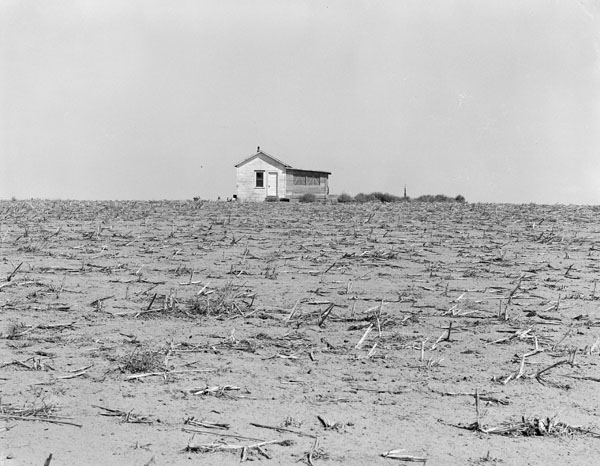Dust Bowl
Pardon Our Noise
We wish to apologize for construction noise in the building. The library is currently undergoing renovations to increase the safety of the building. Please look at the Cornette Library Maintenance and Renovations Libguide for more information.
Door Closure: Due to the construction, the east entrance of the library and portions of the east lawn (facing 26th Street and Centennial Hall) are currently closed. Please use the south entrance until further notice. Note: The Overnight Book Drop is out of service due to the closure. If you are unable to return your books during business hours, please contact Access Services at (806) 651-2215.
Life During the Dust Bowl
Federal Sources
- Voices from the Dust Bowl
- Voices from the Dust Bowl: The Charles L. Todd and Robert Sonkin Migrant Worker Collection is an online presentation of a multi-format ethnographic field collection documenting the everyday life of residents of Farm Security Administration (FSA) migrant work camps in central California in 1940 and 1941. This collection consists of audio recordings, photographs, manuscript materials, publications, and ephemera and is a part of the Library of Congress American Memory project.
- 20th Century Drought
- The National Oceanic and Atmospheric Association (NOAA) created a site using paleoclimatic data, such as studies of tree rings, to study the frequency of past severe droughts in North America and predict the likelihood of such droughts in the future.
- NOAA Photo Library
- NOAA's Photo Library has an image of a 1935 dust storm in Texas in the Meteorological Monsters: Dust collection of their National Weather Service Collection . Another photo shows 1930s western U.S. homes overshadowed by a massive dust storm.
- California Odyssey Project and Dust Bowl Migration Archives
- A collection of "fifty-seven oral history interviews that developed from the CALIFORNIA ODYSSEY Project's Oral History Program funded in 1980 by the National Endowment for the Humanities (NEH). The interviews focus on residents who migrated to the San Joaquin Valley from Oklahoma, Arkansas, Missouri, and Kansas between 1924 and 1939." Also has photographs.
- The Plow That Broke the Plains
- A 25-minute documentary produced in 1936 for the Farm Security Administration to justify New Deal programs that aided farmers hit hard by the Dust Bowl. Contains compelling, historical video clips of the devastation.
Texas Sources
- The Handbook of Texas Online: Dust Bowl
- In-depth article, with bibliography, on the weather and market forces that combined to create the Dust Bowl in Texas and the U.S. government response to the problem. At its height, the bowl covered 100 million acres of the southern plains.
Additional Sources
- Report of the Great Plains Drought Area Committee
- From HathiTrust. This 1936 document discusses the events that led to the occurrence of the Dust Bowl and was submitted to President Franklin D. Roosevelt.
- Surviving the Dust Bowl
- PBS Online has an interactive site for its American Experience show "Surviving the Dust Bowl." Watch the entire film or link to special features that include a timeline and a photo gallery from an eyewitness account of a Kansas farmer. "Dust Bowl Days" lesson plans for students in grades 3-5 is available from the National Endowment for the Humanities. Refresh main web page to see a rotating display of special features.
- Dust Storms and Their Damage
- An archive of dust storm photographs online.
- Postcards of the Great Depression and Dust Bowl
- From the Kansas Historical Society. Collection includes postcards of dust storms.
- Dust Bowl
- Collection of photographs from a variety of sources taken during the dust storms of the 1930s.
Wind Erosion, Drought, and Water Conservation

Federal Sources
- What is Drought?
- Extensive site, from the National Drought Mitigation Center at the University of Nebraska-Lincoln, describing drought and how to plan for, monitor, and mitigate it. Includes sections on The Dust Bowl and Historical Maps of the Palmer Drought Index.
- An Introduction to Wind Erosion Control
- Recommendations from the Alberta (Canada) Agriculture, Food and Rural Development Department on controlling wind erosion.
- U.S. Drought Monitor
- The National Drought Mitigation Center displays maps that show current drought situations in the U.S.
- Wind Erosion & Water Conservation (USDA)
- Agriculture Department unit, located in Lubbock and Big Spring, which "conducts applied and fundamental research on the causes and consequences of wind-induced soil erosion, and the interactions of plants with the soil and atmosphere; to develop wind erosion mitigation strategies and water management strategies that alleviate, delay, or moderate the impact of drought and thermal stress on crop production."
Texas Sources
- Texas Water Development Board: Drought in Texas
- Includes links to information about drought, drought monitoring, outlook and historical data, water-saving tips, and other drought resources.
- High Plains Underground Water Conservation District
- Promotes groundwater conservation to area businesses, homeowners, producers, researchers, and others for 16 counties in the Texas Panhandle. Includes maps, conservation tips, reports, and information on water use.
- Panhandle Groundwater District
- Goal is to preserve 50 percent of current water supplies in its district for 50 years from now. Serves Carson, Donley, Gray, Roberts and Wheeler Counties, along with parts of Armstrong, Hutchinson and Potter Counties. Newsletter has annual detailed water level information.
- Texas Alliance for Water Conservation
- Collaborates to promote profitable crop and livestock systems that can also extend the life of the Ogallala Aquifer. Supports the counties of Floyd, Hale, Lamb, Lubbock, Crosby, Castro, Parmer, Swisher, and Deaf Smith.
Woody Guthrie
- Official Woody Guthrie Website
- Includes biography, discography, filmography, archival finding aids, etc. Selected images are available, such as the drawing "Amarillo Dust Storm" and an original draft of Guthrie's lyrics for The Great Dust Storm (written after his experience in Pampa, Texas).
- Woody Guthrie
- From PBS. Brief biography of the "Dust Bowl Troubadour," from The Dust Bowl/A Film by Ken Burns.